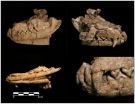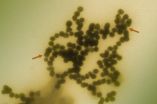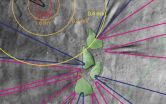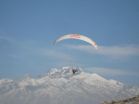Extreme X-ray pulses create unique image of intact virus
2011-02-03
(Press-News.org) They are entirely too small to be seen even with the most powerful microscope. But now an international research team has managed to capture an image of an intact virus and a membrane structure from a photosynthetic bacterium with the aid of extremely intensive and ultra-short x-ray pulses from the world's first free electron laser. This new advance in structural biology is being published today in two articles in the journal Nature.
The findings for the two studies pave the way for studies of biological structures at the molecular level, including viruses, individual cells, cell organelles, and living bacteria. The technology enhances the possibilities of imaging individual biological molecules that are too small to study even with the most powerful microscopes.
- Biologists have long dreamed of being able to capture the image of viruses, single-cell organisms, and bacteria without having to section, freeze, or mark them with metals, as is necessary in electron microscopy. Our studies show that it is really possible to create images with the aid of extremely intensive and ultra-short x-ray pulses that would otherwise destroy everything in their path, says Professor Janos Hajdu from the Division of Molecular Biophysics, Uppsala University.
Together with his colleague Henry Chapman, he has co-directed the international research team, which also includes Inger Andersson's team from the Swedish University of Agricultural Sciences, SLU. The entire international group is currently at Stanford for new experiments with the advanced free electron laser.
X-ray diffraction has been an irreplaceable instrument in identifying biological structures, but this technology requires crystallized samples of sufficient size. Many particles are therefore packed in crystals. For single particles the x-ray dose needs to be increased so much that the particle is destroyed, especially if it comes from biological material. A number of years ago it was suggested that extremely short pulses from a so-called free electron laser would be able to create an image before the particle had time to be damaged. It is this method (read more about the technology below) that is now being tested on biological material.
In the first study, the method was tested on Mimivirus, the world's largest known virus, discovered as recently as 1992. It is larger than some single-cell organisms and the only virus that can be infected by a virus of its own. Its size and special surface structure entails that it cannot be studied using conventional imaging methods such as electron microscopy or x-ray crystallography.
In the other study the team shows that x-ray pulses can also be used to study the structure of vitally important membrane proteins – in this case a protein complex that captures sunlight and converts it to energy in photosynthesizing organisms, here a photosynthetic bacterium. Membrane proteins are essential to life processes, not only as energy converters but also as the cell's transporters and receptors for drugs – but they are incredibly hard to study using conventional methods. The new technology means that huge "blank patches" in structural biology will now be accessible for study at the level of the atom for the first time.
INFORMATION:
About the technology: The world's first free electron laser in the hard x-ray area – the Linac Coherent Light Source (LCLS), at SLAC National Accelerator Laboratory – has a light intensity that surpasses conventional synchrotrons by a billion times, so intensive that it can cut through steel. A single pulse that is focused on a micrometer-size point contains as much energy as all sunlight hitting the earth focused to a square millimeter. The light pulses are extremely short (50-70 femtoseconds, 1 fs = 10-15 sec), which means that can replicate the image of a micrometer-size virus, before it is heated up to 100,000 degree centigrade and is destroyed. LCLS came into use in October 2009, and the studies in question were performed in December that year.
END
ELSE PRESS RELEASES FROM THIS DATE:
2011-02-03
– Early, correct diagnosis is the best way to prevent the development of Lyme arthritis in individuals with the tick-borne illness, according to a paper published in the Journal of the American Academy of Orthopaedic Surgeons (JAAOS). In patients who do develop the condition, most cases can be treated successfully with antibiotics, the review found.
"Lyme arthritis occurs commonly in patients with Lyme disease and should be considered when evaluating patients with joint complaints and who live in areas where the disease occurs," said study author Aristides Cruz, MD, ...
2011-02-03
Fifteen members of the Entomological Society of America (ESA) gave presentations at the "Second Annual National Bed Bug Summit: Advancing Towards Solutions to the Bed Bug Problem," held by the U.S. Environmental Protection Agency (EPA) in Washington, DC, February 2, 2011.
The meeting focused on what is being done to combat bed bugs, the importance of educating consumers, improvements in prevention and control techniques, controlling bed bugs in schools and public housing, and on the state of bed bug knowledge and futue research needs.
"Many health departments are overwhelmed ...
2011-02-03
PHILADELPHIA – A simple test performed at the sideline of sporting events can accurately detect concussions in athletes, according to study by researchers at the University of Pennsylvania School of Medicine. Current sideline tests can leave a wide amount a brain function untested following concussion. Penn researchers showed that this simple test was superior to current methods and accurately and reliably identified athletes with head trauma. The study appears online now in Neurology.
The one-minute test involves the athlete reading single digit numbers displayed on index-sized ...
2011-02-03
Food scientists at the University of British Columbia have been able to pinpoint more of the complex chemistry behind coffee's much touted antioxidant benefits, tracing valuable compounds to the roasting process.
Lead author Yazheng Liu and co-author Prof. David Kitts found that the prevailing antioxidants present in dark roasted coffee brew extracts result from the green beans being browned under high temperatures.
Their findings will appear in a forthcoming issue of Food Research International and can be previewed at: http://dx.doi.org/10.1016/j.foodres.2010.12.037
Liu ...
2011-02-03
TORONTO, ON – Anthropologists at the University of Toronto and the University of Cambridge have discovered the oldest cemetery in the Middle East at a site in northern Jordan. The cemetery includes graves containing human remains buried alongside those of a red fox, suggesting that the animal was possibly kept as a pet by humans long before dogs ever were.
The 16,500-year-old site at 'Uyun al-Hammam was discovered in 2000 by an expedition led by University of Toronto professor Edward (Ted) Banning and Lisa Maher, an assistant professor of anthropology at U of T and research ...
2011-02-03
HOUSTON (Feb. 2, 2011) -- For women seeking pregnancy by assisted reproductive technologies, such as in-vitro fertilization (IVF), a new study shows that the health of the uterus is more relevant than egg quality for a newborn to achieve normal birth weight and full gestation. This study, published in Fertility and Sterility, an international journal for obstetricians, offers new information for women with infertility diagnoses considering options for conceiving.
The study was conducted by Dr. William Gibbons, director of The Family Fertility Program at Texas Children's ...
2011-02-03
The same properties that make engineered nanoparticles attractive for numerous applications—small as a virus, biologically and environmentally stabile, and water-soluble—also cause concern about their long-term impacts on environmental health and safety (EHS). One particular characteristic, the tendency for nanoparticles to clump together in solution, is of great interest because the size of these clusters may be key to whether or not they are toxic to human cells. Researchers at the National Institute of Standards and Technology (NIST) have demonstrated for the first time ...
2011-02-03
Pasadena, Calif.—The brain—awake and sleeping—is awash in electrical activity, and not just from the individual pings of single neurons communicating with each other. In fact, the brain is enveloped in countless overlapping electric fields, generated by the neural circuits of scores of communicating neurons. The fields were once thought to be an "epiphenomenon, a 'bug' of sorts, occurring during neural communication," says neuroscientist Costas Anastassiou, a postdoctoral scholar in biology at the California Institute of Technology (Caltech).
New work by Anastassiou ...
2011-02-03
SALT LAKE CITY, Feb. 2, 2011 – During the past two months, researchers launched weather balloons, drove instrument-laden cars and flew a glider to study winter inversions that often choke Salt Lake City in smog and trap dirty air in other urban basins worldwide.
The field campaign – part of a three-year study by the University of Utah and other institutions – ends Monday, Feb. 7 as atmospheric scientists begin analyzing data they collected to learn how weather conditions contribute to inversions, which occur when warmer air aloft holds cold air ...
2011-02-03
Academic Medical Centers (AMCs) must adjust and adapt to the new health care reform laws or risk marginalization in the new health care arena, according to a New England Journal of Medicine Perspective article published online February 2.
The authors of the article, Scott A. Berkowitz, M.D., M.B.A., a fellow in cardiology and geriatrics at the Johns Hopkins University School of Medicine, and Edward D. Miller, M.D., dean and CEO of Johns Hopkins Medicine, argue that AMCs can not only remain relevant in the face of sweeping change, but can lead the way by serving as examples ...
LAST 30 PRESS RELEASES:
[Press-News.org] Extreme X-ray pulses create unique image of intact virus



